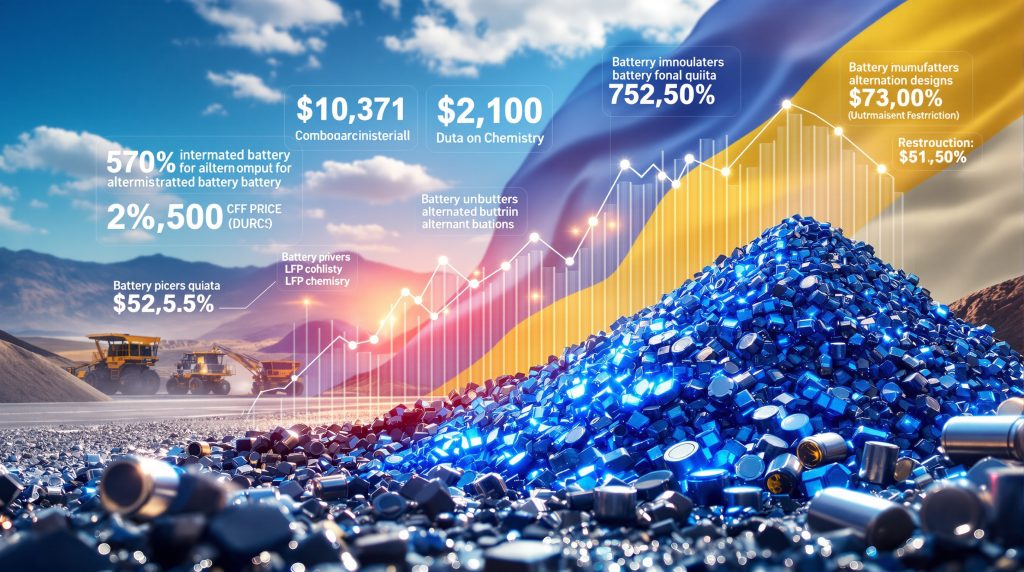Cobalt Price Rally: Battery Industry Risks and Market Implications
The Democratic Republic of Congo has dramatically transformed the global cobalt market through aggressive export controls, creating ripple effects throughout battery supply chains and raising significant concerns for manufacturers worldwide. As prices surge in response to these restrictions, battery makers face difficult decisions about material sourcing and technology pathways that could reshape the industry's future.
How Congo's Export Control Is Reshaping the Cobalt Market
The cobalt market has experienced dramatic volatility since February 2025, when the Democratic Republic of Congo (DRC) implemented an eight-month ban on cobalt shipments. This unprecedented move came after benchmark prices had fallen below $10 per pound—hitting lows not seen in over two decades except for a brief period in late 2015.
Following the initial ban, the DRC has now transitioned to a quota system that will severely restrict global supply. The impact has been immediate and substantial across global markets:
- Benchmark cobalt prices have doubled since export restrictions began
- Cobalt hydroxide prices have more than tripled during the same period
- Despite this significant rally, current prices remain less than half of their 2018 and 2022 peak levels
The New Quota System Structure
The DRC's quota implementation creates severe supply constraints that will reshape global markets for years to come:
- Approximately 18,000 tons permitted for export during the remainder of 2025
- Maximum 96,600 tons annually permitted for 2026 and 2027
- These quotas represent less than 50% of the country's 2024 production
This dramatic reduction from a country that controls roughly 75% of global cobalt production has sent shockwaves through battery supply chains and forced manufacturers to reconsider their material strategies.
Why Battery Manufacturers Are Approaching a Price Tolerance Threshold
The Economic Breaking Point
Battery manufacturers are increasingly concerned that cobalt prices have reached unsustainable levels. According to Kenny Ives, Chief Commercial Officer at CMOC Group Ltd. (one of the world's largest cobalt producers), current price levels are "at the upper end of what people will tolerate without being forced to switch."
This assessment highlights the delicate balance between supply constraints and demand sustainability as manufacturers evaluate their options. The economics of battery production are especially sensitive to input costs, with material expenses representing 50-70% of the final battery pack cost.
Alternative Battery Chemistry Acceleration
The cobalt price rally creates powerful economic incentives for battery manufacturers to accelerate their transition to alternative chemistries:
| Battery Technology | Cobalt Content | Market Adoption Status |
|---|---|---|
| Traditional NMC | High | Declining |
| LFP (Lithium Iron Phosphate) | None | Rapidly increasing |
| High-nickel NMC | Reduced | Growing |
| Solid-state | Varies by design | In development |
Most electric vehicle manufacturers in China—the world's largest EV market—have already pivoted toward LFP cells that eliminate cobalt entirely from their supply chains. As Ives noted: "If you starve the downstream of cobalt units, clearly there are different chemistry options and the Chinese and others will switch."
Industry analysts expect Western manufacturers to follow this trend if prices remain elevated, potentially accelerating mining industry evolution that was already underway for cost and supply security reasons.
How Congo's Quota System Creates Disproportionate Market Impact
Major Producers Face Severe Constraints
CMOC Group faces particularly severe constraints under the DRC's new regulatory framework. The Chinese mining giant produced 114,000 tons of cobalt in 2024 from its two DRC mines, but under the new quotas, CMOC will only be permitted to export approximately 27% of its production volume in 2026.
This dramatic reduction forces major producers to make difficult decisions about production levels, stockpiling strategies, and market positioning. Unlike smaller producers who might be able to export their entire production under quota allocations, the largest operators face disproportionate impacts.
Copper Production Continues Despite Cobalt Constraints
An important dynamic in the cobalt market is its relationship with copper production. Despite cobalt export limitations, CMOC and other producers will continue expanding their mining operations because:
- Cobalt is extracted as a by-product of copper mining
- Copper prices are trading near all-time highs
- Market analysts widely anticipate continued copper price insights
CMOC's copper production from its Congolese operations is projected to reach 700,000 tons in 2025—nearly 8% higher than the previous year—with significant additional growth expected over the next 3-5 years. As Ives explained, continued copper extraction "produces a lot of cobalt" regardless of export restrictions.
This creates a scenario where cobalt production will continue even as mining export controls limit market access, potentially leading to stockpile accumulation and further market distortions.
What Factors Created the Cobalt Market Imbalance?
Supply-Side Expansion
The cobalt market was described as "saturated" when Congo imposed its export ban, but industry experts note this wasn't solely due to CMOC's production increases in the DRC. Multiple factors contributed to the oversupply:
- Rapid expansion of Indonesian nickel-cobalt production
- Reactivation of previously idled mines in response to earlier high prices
- New production coming online from various global sources
- Efficiency improvements in extraction and processing
These supply increases created downward pressure on prices throughout 2023-2024, eventually triggering the DRC's intervention to protect price levels.
Demand-Side Disappointments
Equally important to the market imbalance has been what Kenny Ives characterized as "very underwhelming" demand growth for cobalt over recent years. This demand weakness stems from:
- Faster-than-expected adoption of cobalt-free battery chemistries
- Economic headwinds affecting overall EV adoption rates
- Manufacturers' strategic stockpiling followed by inventory drawdowns
- Efficiency improvements reducing cobalt intensity per battery
The combination of supply increases and demand disappointments created the price collapse that ultimately triggered Congo's export intervention.
How Might Congo's Export Policy Evolve?
Potential for Policy Adjustment
Industry insiders suspect Congo may reconsider its quota system "on a semi-regular or a regular basis" according to CMOC's Kenny Ives. This suggests the possibility of a more dynamic regulatory approach that responds to:
- Price movements in the global cobalt market
- Domestic economic and political considerations
- Pressure from major mining companies
- Global supply chain adaptations
This potential for policy adjustment creates additional uncertainty for market participants already grappling with supply constraints.
Strategic National Interests
The DRC's policy approach reflects broader strategic objectives:
- Capturing greater value from its natural resources
- Developing domestic processing capabilities
- Strengthening its position in global supply chains
- Supporting price levels to maximize export revenues
These strategic interests suggest that while implementation details may evolve, the fundamental direction toward greater resource nationalism is likely to persist.
How Will Battery Supply Chains Adapt to Cobalt Volatility?
Technology Pathway Acceleration
The cobalt price volatility is likely to accelerate several industry trends:
- Greater investment in cobalt-free battery research
- Vertical integration of supply chains by major manufacturers
- Development of battery recycling breakthrough technologies
- Geographic diversification of battery material sourcing
Battery manufacturers have been working to reduce cobalt dependency for years, driven by both cost and ethical sourcing concerns. The current price spike and supply uncertainty will likely accelerate these efforts across the industry.
Strategic Stockpiling
The supply uncertainty has prompted strategic responses from various stakeholders:
- The US government is seeking to stockpile cobalt for the first time in decades
- Battery manufacturers are securing long-term supply agreements
- Automotive companies are investing directly in mining projects
- Trading companies are building strategic inventory positions
These stockpiling efforts may create additional short-term price pressures while providing some longer-term supply security for key industrial consumers.
Where Will New Cobalt Production Emerge?
Geographical Diversification Efforts
The DRC's export restrictions are catalyzing efforts to develop cobalt resources elsewhere:
| Country | Development Status | Production Potential |
|---|---|---|
| Indonesia | Rapidly expanding | High |
| Australia | Moderate growth | Medium |
| Canada | Early development | Medium |
| Morocco | Exploration phase | Low-Medium |
| Russia | Steady production | Medium |
While these alternative sources are promising, industry analysts note that none can fully replace Congo's dominant position in the near term. The DRC accounts for approximately 75% of global cobalt output, creating a concentration risk that cannot be quickly diversified.
Recycling as a Critical Supply Source
Battery recycling is emerging as an increasingly important source of cobalt:
- Recovery rates from used batteries can exceed 95%
- Growing volumes of end-of-life batteries becoming available
- Regulatory frameworks increasingly mandating recycling
- Economic incentives improving with higher primary material prices
Recycling offers the dual benefits of reducing reliance on primary production while also addressing environmental concerns about battery waste. However, meaningful volumes from recycling will take time to develop as battery lifecycles typically range from 8-12 years.
What Market Signals Will Indicate Future Price Direction?
Key Indicators for Market Participants
Several key indicators will signal how the market is adapting to the new supply constraints:
- Price premiums for cobalt hydroxide – reflecting processing bottlenecks
- Battery chemistry announcements from major manufacturers
- Investment in alternative cobalt sources outside the DRC
- Policy adjustments by the Congolese government
- Inventory levels at major consumers and traders
Sophisticated market participants are closely monitoring these signals to anticipate potential price movements and supply chain disruptions.
Technological Inflection Points
The market will also be shaped by technological developments:
- Commercialization timelines for solid-state batteries
- Efficiency improvements in cobalt-free chemistries
- Advances in recycling technologies
- Novel extraction methods for lower-grade deposits
These technological factors could significantly alter demand patterns and price sensitivity over the medium term, as highlighted in recent Congo's cobalt export shock analysis.
FAQ: Critical Questions About Cobalt's Market Outlook
How concentrated is global cobalt production?
The Democratic Republic of Congo accounts for approximately 75% of global cobalt production, making it the dominant supplier to world markets. This concentration creates significant supply security risks and gives the DRC substantial pricing power.
What applications compete with batteries for cobalt?
While batteries represent the largest and fastest-growing application, cobalt is also essential for:
- Superalloys used in aerospace and gas turbines
- Permanent magnets for various industrial applications
- Chemical catalysts for petroleum refining
- Hard metal tools and cutting surfaces
- Medical implants requiring biocompatibility
These diverse applications create additional demand resilience but also compete with battery manufacturers for available supply.
Can battery manufacturers quickly pivot away from cobalt?
The transition timeline varies by segment:
- Consumer electronics can adapt relatively quickly (1-2 years)
- Automotive applications typically require 3-5 years for qualification
- Industrial and specialty applications often have longer transition periods
- Aviation and defense applications face the strictest performance requirements
These varying timelines create different exposure levels across industries, with automotive manufacturers caught between lengthy qualification processes and high volume requirements.
Will cobalt prices continue rising through 2026?
Market analysts are divided on the medium-term price outlook:
- Supply constraints support higher prices in the near term
- Technology transitions create downside risk over 2-3 years
- DRC policy adjustments remain a significant uncertainty factor
- Global economic conditions will influence overall demand strength
The balance between these competing factors will determine whether prices stabilize at current levels or experience further volatility, according to detailed cobalt market outlook analyses.
How does artisanal mining influence market dynamics?
Artisanal mining represents a significant portion of DRC production with unique market characteristics:
- More responsive to price signals than industrial production
- Subject to increasing scrutiny over labor practices
- Typically higher-cost production with variable quality
- More challenging to regulate under formal quota systems
The role of artisanal production adds another layer of complexity to market forecasting and supply reliability assessments.
How Can Stakeholders Navigate Cobalt Market Volatility?
Risk Management Strategies
Different market participants require tailored approaches to manage cobalt price and supply risks:
- Battery manufacturers should accelerate technology diversification while securing strategic supply agreements
- Automotive companies benefit from vertical integration and direct investment in mining assets
- Electronics producers can leverage their faster product cycles to adopt new technologies more rapidly
- Investors should closely monitor both policy developments and technology transitions
The most successful strategies will combine supply security measures with technology flexibility to navigate an increasingly complex market landscape.
Long-term Strategic Positioning
Beyond immediate risk management, stakeholders should consider how cobalt market disruptions might create strategic opportunities:
- Technology leadership in cobalt-free alternatives
- Processing innovations to improve material efficiency
- Supply chain transparency as a competitive advantage
- Recycling infrastructure development in key markets
Organizations that view current disruptions through a strategic lens may find opportunities to create lasting competitive advantages while addressing immediate challenges.
The cobalt price rally highlights the complex interplay between resource nationalism, technological evolution, and critical minerals strategy that increasingly characterizes critical minerals markets worldwide. As battery manufacturers navigate these challenges, their responses will shape not only their own competitiveness but also the broader trajectory of the energy transition.
Want to Stay Ahead of the Next Major Mining Discovery?
Discovery Alert's proprietary Discovery IQ model instantly identifies significant ASX mineral discoveries, providing real-time notifications that could help you capitalise on opportunities before the broader market. Discover why historic mineral finds like those mentioned in this article can generate substantial returns by visiting the Discovery Alert discoveries page.




